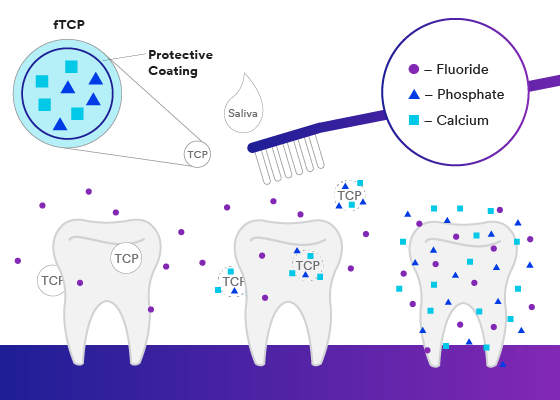Managing caries and motivating change, part 2: Motivational interviewing
How do you motivate your patients? Discover how caries risk assessments and motivational interviewing tactics can help you connect with…


Fluoride and calcium both play critical roles in healthy teeth, but they can only do their work if they get to the tooth intact. See how one innovative, “smart” ingredient can help improve mineral delivery – for stronger, healthier smiles.
Caries may be the most prevalent dental disease worldwide, but there have been significant reductions over the past 30 years due to nearly universal use of oral care products containing fluoride. Fluoride toothpastes, oral rinses, and professionally applied products, such as varnishes and sealants, have helped build a strong culture of caries prevention.1
However, caries prevention means much more than fluoride. Teeth are complex, highly mineralized structures mostly made of hydroxyapatite, a crystalized form of calcium and phosphate. And as such, these minerals play a critical role in maintaining healthy teeth. In fact, fluoride works by holding onto calcium and phosphate in the mouth, which helps to inhibit demineralization and enhance remineralization. Fluoride then merges with the existing tooth structure to support calcium and phosphate – replacing normal hydroxyapatite with a stronger, more acid-resistant mineral, fluorapatite.

With this in mind, we’ve expanded our understanding of remineralization beyond fluoride in recent years, further addressing the roles calcium and phosphate play in the process. While fluoride, calcium, and phosphate all play vital roles in healthy teeth, clinical trials have shown that products with high concentrations of both calcium and fluoride don’t always guarantee greater protection against tooth decay.2 That’s because calcium and fluoride can combine prematurely during storage to form calcium fluoride, which can reduce fluoride’s efficacy. With this in mind, 3M developed a new ingredient designed to control mineral delivery in dental products in 2009: functionalized tri-calcium phosphate (fTCP).
fTCP is a “smart” ingredient that effectively protects itself from unwanted mineral interactions during storage. fTCP can be broken down in two distinct parts, TCP and what makes it functionalized (f).
TCP is a mineral system made of calcium and phosphate – the building blocks of healthy teeth, found naturally in saliva – arranged similarly to teeth’s natural mineral structure, hydroxyapatite. Its low solubility in water makes it ideal for dental products, as it won’t dissolve immediately – giving it more time to rebuild mineral in the tooth. On its own, TCP is not a new concept and is featured in some dental products for its beneficial mineral content. However, TCP can only work if it reaches the tooth intact – which is where 3M innovation comes in handy.
TCP can be functionalized (f) by a protective coating that eliminates the risk of early interactions with fluoride during storage. Once in the mouth, however, saliva breaks down the coating and releases the calcium and phosphate at the tooth surface. From there, the released minerals work with fluoride to initiate high-quality mineral growth – supporting natural tooth structure and building the high-quality, acid-resistant mineral, fluorapatite.

In addition, this innovative technology has been tailored for specific products, their unique chemistries, and how long they’re intended to be in the mouth. Toothpaste is water-based with water-soluble ingredients like glycerol and sorbitol and is only meant to be in the mouth for two minutes – so the functional coating is made of sodium lauryl sulfate (SLS), a common water-soluble surfactant. This enables beneficial materials to reach their destination in the right amount of time.
Varnishes, on the other hand, are not water-based and are designed to spend more time in the mouth – meaning a different coating is necessary. Fortunately, fTCP can be fine-tuned for product compatibility. 3M™ Vanish™ 5% Sodium Fluoride White Varnish, for example, is an alcohol-based suspension of modified rosin that features fTCP with a fumaric acid coating. Fumaric acid is a naturally occurring, food-grade acid with low water solubility, which allows the coating to wear down and release calcium and phosphate over time.
These efforts are only as valid as their results – and these results’ consistency – which comes from time and testing.
In the case of fTCP enhanced toothpaste, both 3M™ Clinpro™ Tooth Crème and 3M™ Clinpro™ 5000 Anti-Cavity Toothpaste (1.1% Sodium Fluoride) were tested for fluoridating efficiency and remineralizing capability. To simulate regular tooth brushing, enamel samples with incipient caries lesions were subjected to 20-day pH cycling, with four 2-minute treatments per day, with enamel fluoride uptake (EFU) and remineralization measured at 10- and 20-day increments. Not only did both teeth demonstrate increased EFU, but each lesion also dramatically improved, with the tooth treated with Clinpro Tooth Crème showing 40% increased remineralization (fig 1), while clinical-strength Clinpro 5000 Anti-Cavity Toothpaste enabled complete remineralization (fig. 2)

Figure 1: After 20-day pH cycling, 3M™ Clinpro™ Tooth Crème 0.21% Sodium Fluoride Anti-Cavity Toothpaste exhibits greater enamel fluoride uptake than competitive products and exhibited 40% increased mineral recovery.

Figure 2: After 20-day pH cycling, 3M™ Clinpro™ 5000 1.1% Sodium Fluoride Anti-Cavity Toothpaste exhibits greater enamel fluoride uptake than competitive toothpaste and complete mineral recovery.
Dental professionals know that when it comes to caries prevention, basic brushing and flossing on their own aren’t always enough. And in those instances, there’s only so much you can do in the office. That’s where innovative fluoride treatments, particularly those that contain fTCP, can lend a hand, helping give patients a much-needed boost of beneficial minerals when and where they’re needed most.
For more details on fTCP and how best to utilize 3M products, check out our Remineralization White Paper, or our At-Home and In-Office Fluoride Protocol.
1. Title 21 Code of Federal Regulations, Part 355 Anticaries Drug Products for Over-The-Counter Human Use, Source: 60 FR 52507, October 6, 1995.
https://www.accessdata.fda.gov/scripts/cdrh/cfdocs/cfCFR/CFRSearch.cfm
2. GK Stookey, Are all fluorides the same? In: Clinical uses of fluorides, Wei SHY, editor, 1984; Philadelphia: Lea & Febiger; pp. 105-131.

How do you motivate your patients? Discover how caries risk assessments and motivational interviewing tactics can help you connect with…

Caries is a complicated multifactorial disease. In this two-part series, explore how caries risk assessments can help improve evaluation and…

Zirconia may be part of your everyday vocabulary, but how much do you know about this ceramic material? Learn more…